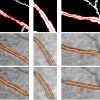Free Online Productivity Tools
i2Speak
i2Symbol
i2OCR
iTex2Img
iWeb2Print
iWeb2Shot
i2Type
iPdf2Split
iPdf2Merge
i2Bopomofo
i2Arabic
i2Style
i2Image
i2PDF
iLatex2Rtf
Sci2ools
CVPR
2009
IEEE
2009
IEEE
Extraction of Tubular Structures over an Orientation Domain
This paper presents a new method to extract a network of vessels centerlines from a medical
image. The network is composed of local geodesics over a four-dimensional space that includes
local orientation and scale. These shortest paths follow closely the center of tubular structures
and can deal robustly with crossings over the image plane. The vessel network is grown
by an iterative algorithm that distributes seed points according to a geodesic saliency field.
Numerical experiments on a database of synthetic and medical images show the superiority
of our approach with respect to several methods based on shortest paths extractions. With
a minimum of user interaction, it allows to compute a complex network of vessels over noisy
medical.
| Added | 09 May 2009 |
| Updated | 10 Dec 2009 |
| Type | Conference |
| Year | 2009 |
| Where | CVPR |
| Authors | Gabriel Peyré, Mickaël Péchaud, Renaud Keriven |
Comments (0)

